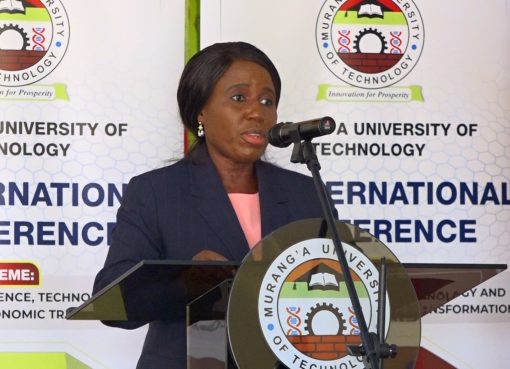Key players in the forestry sector have backed a proposal that will see the resumption of harvesting of mature trees in gazetted plantations.
Addressing the media on the sidelines of a public participation workshop on disposal of forestry plantation materials at the White Rhino Hotel, the stakeholders also pledged to continue in assisting the state in attaining the 15-billion tree afforestation target by 2032.
The workshop brought together officers from the Kenya Forest Service (KFS), Kenya Forest Research Institute (KEFRI), the Ministry of Environment, Climate Change, and Forestry, sawmillers, and members of Community Forest Associations (CFA) from the Mount Kenya region.

The State plans to harvest a total of 5,000 hectares of its mature forest plantation during the 2023–2024 financial year, pursuant to Section 43 of the Forest Conservation and Management Act (FCMA) 2016.
Out of the 2.6 million hectares of government-protected forests, 150,000 hectares are zeroed as plantation establishments, accounting for about six per cent of the country’s forest cover.
“We are here to discuss the future of our industry. There is a plan to harvest 5,000 hectares of mature and ready-to-harvest trees. I want to tell you that 5,000 hectares is less than two per cent of the plantation acreage that we have in our country. So, this is a small figure we are going to operate from,” said John Wakaba, who is the national secretary-general for the Timber Manufacturers Association.
“Nevertheless, these 5,000 hectares of trees will be a very big advantage to our industry. At the moment, we employ at least 20,000 people directly. If we are to include our cluster industry, we employ about 2 million people. This is a population that consists of young men and young women who would otherwise be jobless but now have something to do. We are also going to support the low-cost housing construction industry, which our President (Dr. William Ruto) started,” he continued.
The lumberjack similarly noted that the ban on logging had so much affected their businesses that some of their 800 registered timber dealers had slipped into depression after their wares and property were auctioned by financial lenders.
He said the moratorium forced them to cross over into neighbouring countries like Tanzania to look for timber, an undertaking which came with a myriad of risks owing to the costs involved in transportation and border clearance fees.
Wakaba also said some of the centres that had thrived out of the timber industry due to proximity to plantation forests, such as Molo and Elburgon, witnessed business activities literally grind to a halt.
“When the ban on logging came into force, all our softwood timber was coming from Tanzania, and our country was losing a lot of foreign exchange. But now we are going to create our own revenue, and we are going to be partners with Kenya Forest Service through planting trees where we are going to harvest,” he stated.
James Maina Wambugu, chairperson for the Zaina Community Forest Association, has lauded the move to reintroduce harvesting of mature plantation trees, saying it will ensure the continuation of the Plantation Establishment for Livelihood Improvement Scheme (Pelis), which is a source of livelihood for hundreds of families living near forests.
Wambugu noted that since the state outlawed the felling of mature exotic trees in government forests, families that had been taking care of the plantations while tending their food crops in such areas had sunk into poverty.
In addition, hundreds of tree seedlings that had attained the age of transplanting had already overgrown and were therefore unfit for planting.
“We fully support this proposal since it will not only allow the harvesting of mature plantation trees but also give us an opportunity to continue taking care of the growing trees as we tend our food crops. Before the ban on harvesting was invoked, we used to grow a lot of food crops here, which ensured there was food security and money in our pockets. Right now, much of this work has stopped, with our seedlings in our nurseries going to waste as they are already overgrown and therefore unfit for planting,” he said.
County Commissioner Pius Murugu, who opened the one-day event, said that since President Dr. Ruto launched the 15 billion tree planting campaign last year, Nyeri has so far managed to plant 6 million trees.
He said the programme has been so successful that they are now appealing for KFS and KEFRI to support the government with more seedlings since they have run out of supplies. Murugu said the County is now targeting to move its forest cover from the current 40 per cent to 50 per cent before the end of this decade.
“Since we started tree-growing in March this year, Nyeri has been able to plant slightly over 6 million trees. I would like to thank all the stakeholders in the environment sector because the county’s forest cover is slightly above 40 per cent, and even with the presidential directive, we have continued to plant trees.
So Nyeri contributes a lot towards sustaining Kenya’s ecosystem. Our target is to have slightly above 50 per cent forest cover. In every location, we have to plant 3,000 trees every month. Cumulatively, that is how we are working,” he told participants.
“The challenges we are having in Nyeri as far as tree planting is concerned is we have depleted. Almost all the seedlings were available, and we are hoping that the Kenya Forest Service and other stakeholders will be able to get more seedlings because, with that ambitious programme, we are depleting seedlings very fast. The other challenge is space. You realise that almost everywhere, with 40 per cent tree cover, getting a space to plant is a very big problem,” he added.
Nyeri County is targeting to increase its forest cover from the current 40.89 per cent to 43 per cent by the year 2027.
The state imposed a ban on logging on February 24, 2018, which effectively restricted the extraction of timber from all public and community forests.
The moratorium was arrived at following the findings of a task force that had been constituted by the government to inquire into forest resource management and logging activities in the country.
The task force found out that the board and the management of KFS had been unable to “stem and, in some instances, have directly participated in, abated, and systematised rampant corruption and abuse of office” in undertaking the harvesting of forest products.
Forest plantations currently cover at least 335,000 acres in all gazetted reserves in Kenya, including Mount Kenya, Aberdare, Mau Forest Complex, Cherangani Hills, and Mt. Elgon.
In 2019, sawmillers across the country raised concern over the ban on logging, saying trees worth billions of shillings were rotting in the government forests and, in the process, denying Treasury at least 30 billion shillings annually in lost revenue.
According to the 2020 Economic Survey Report, the total public forest cover rose from 141,600 hectares in 2018 to 147,600 hectares in 2019 as a result of the ban on logging.
Kenya had hoped to attain its target of 10 per cent forest cover by this year, according to projections by the Kenya National Bureau of Statistics released in 2020, a feat that remains elusive.
By Samuel Maina and Wangari Mwangi





